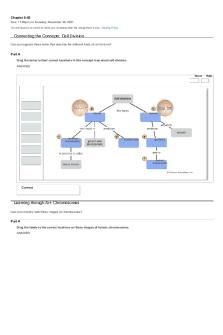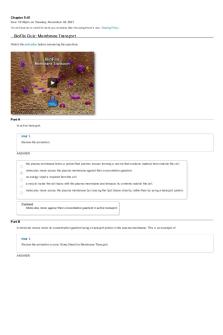Chapter 8-02 - Pearson - Homework PDF

| Title | Chapter 8-02 - Pearson - Homework |
|---|---|
| Course | Biological Principles For Non-Majors |
| Institution | Broward College |
| Pages | 22 |
| File Size | 1.3 MB |
| File Type | |
| Total Downloads | 7 |
| Total Views | 159 |
Summary
Pearson - Homework...
Description
Chapter 8-02 Due: 11:59pm on Tuesday, November 30, 2021 You will receive no credit for items you complete after the assignment is due. Grading Policy
Connecting the Concepts: Cell Division Can you organize these terms that describe the different kinds of cell division?
Part A Drag the terms to their correct locations in this concept map about cell division. ANSWER: Reset
mitosis
asexual reproduction
meiosis
somatic cells
gametes
sexual reproduction
Correct
Learning through Art: Chromosomes Can you correctly label these images of chromosomes?
Part A Drag the labels to the correct locations on these images of human chromosomes. ANSWER:
Help
Reset
Help
homologous chromosomes
centromere
autosomes sister chromatids
sex chromosomes
karyotype
Correct
Figure Walkthrough: The Human Life Cycle Watch this video and then answer the questions.
Part A The figure shows the human life cycle. Can you identify the structures and processes? Drag the labels to their appropriate locations on the figure. Labels of Group 1 represent structures, and labels of Group 2 represent processes. ANSWER:
Reset
Haploid gametes
Egg cell
Sperm cell
Meiosis
Fertilization
Multicellular, diploid adults
Diploid zygote
Mitosis
Correct
Part B Which of the following is true about the human life cycle? ANSWER:
Zygotes are haploid cells. Gametes are produced by meiosis. Egg cells are diploid, while sperm cells are haploid. Meiosis produces diploid cells from haploid cells.
Correct Haploid gametes join in fertilization, producing a diploid zygote.
Part C Select all the true statements about human gametes. ANSWER:
Help
Meiosis in testes produces haploid sperm. Meiosis in ovaries produces haploid eggs. Both eggs and sperm contribute 23 chromosomes to the zygote. Gametes contain 23 pairs of chromosomes.
Correct Both the egg and sperm are haploid. Each contains 23 chromosomes. Fertilization produces a diploid zygote with 23 pairs of chromosomes, 46 chromosomes total.
Learning through Art: Human Life Cycle Can you correctly label this diagram of the human life cycle?
Part A Drag the labels onto the diagram to identify the stages of the life cycle. Not all labels will be used. ANSWER:
Reset
gametes
triploid
haploid
meiosis
fertilization
diploid
zygote
mitosis
Correct
BioFlix Activity: Meiosis -- Overview Can you fill in the meiosis concept map? To review meiosis, watch this BioFlix animation: Meiosis.
Part A - Meiosis concept map Drag the terms to complete the concept map below. ANSWER:
Help
Reset
diploid organisms
haploid gametes
meiosis II maternal chromosomes crossing over occurs sister chromatids separate
Correct
BioFlix Quiz: Meiosis Watch the animation before answering the questions.
Part A Meiosis starts with a single diploid cell and produces
Hint 1. Review the animation or your Study Sheet for Meiosis
ANSWER:
Help
two diploid cells. two haploid cells. eight haploid cells. four haploid cells. four diploid cells.
Correct Meiosis produces four haploid cells.
Part B A cell preparing to undergo meiosis duplicates its chromosomes during
Hint 1. Review the animation.
ANSWER:
interphase. prophase I. anaphase I. metaphase I. meiosis II.
Correct Chromosomes are duplicated during interphase.
Part C During prophase I of meiosis,
Hint 1. Review the animation.
ANSWER:
homologous chromosomes stick together in pairs. there are four haploid daughter cells. chromosome pairs are positioned in the middle of the cell. the homologous chromosomes separate and move towards opposite poles. there are two daughter cells, each with 23 chromosomes.
Correct Homologous chromosomes stick together in pairs during prophase I.
Part D
The correct order of events during meiosis is
Hint 1. Review the animation or your Study Sheet for Meiosis.
ANSWER:
metaphase I, prophase I, telophase I, anaphase I, cytokinesis, meiosis II. prophase I, anaphase I, metaphase I, telophase I, meiosis II, cytokinesis. metaphase I, prophase I, anaphase I, telophase I, cytokinesis, meiosis II. prophase I, anaphase I, telophase I, metaphase I, meiosis II. prophase I, metaphase I, anaphase I, telophase I, cytokinesis, meiosis II.
Correct Meiosis starts with prophase I and continues with metaphase I, anaphase I, telophase I, and cytokinesis. This is followed by meiosis II.
Part E During meiosis, segments of nonsister chromatids can trade places. This recombination of maternal and paternal genetic material is a key feature of meiosis. During what phase of meiosis does recombination occur?
Hint 1. Review the animation.
ANSWER:
prophase I. anaphase I. Metaphase I. meiosis II. telophase I.
Correct Segments of nonsister chromatids trade places during prophase I, resulting in recombination.
BioFlix Activity: Meiosis -- Chromosome Structure Can you identify the structures of a chromosome? To review chromosome structure, watch this BioFlix animation: Meiosis.
Part A - Homologous chromosomes Drag the labels onto the diagram to identify the various chromosome structures. ANSWER:
Reset
Pair of homologous chromosomes
Centromere
Sister chromatids
Correct
BioFlix Activity: Meiosis -- Meiosis I Can you identify the sequence of events in meiosis I? To review meiosis I, watch this BioFlix animation: Meiosis.
Part A - The first stage of meiosis Drag each image to the phase of meiosis I it depicts. ANSWER:
Help
Reset
Correct
BioFlix Activity: Meiosis -- Meiosis II Can you identify the sequence of events in meiosis II? To review meiosis II, watch this BioFlix animation: Meiosis.
Part A - The second stage of meiosis Drag each image to the phase of meiosis II it depicts. ANSWER:
Help
Reset
Correct
Activity: Meiosis Animation
Click here to complete this activity. Then answer the questions.
Part A Meiosis I produces _____ cells, each of which is _____. ANSWER:
two... diploid four ... diploid four ... haploid two... identical to the other two ... haploid
Help
Correct At the end of meiosis I there are two haploid cells.
Part B Meiosis II typically produces _____ cells, each of which is _____. ANSWER:
four ... identical to the other two ... haploid two... diploid four ... haploid four ... diploid
Correct At the end of meiosis II there are typically 4 haploid cells.
Part C During _____ sister chromatids separate. ANSWER:
interphase prophase I metaphase I prophase II anaphase II
Correct Anaphase II is essentially the same as mitotic anaphase except that the cell is haploid.
Part D At the end of _____ and cytokinesis, haploid cells contain chromosomes that each consist of two sister chromatids. ANSWER:
telophase interphase telophase II telophase I metaphase II
Correct At the end of telophase I and cytokinesis, there are two haploid cells with chromosomes that consist of two sister chromatids each.
Part E Synapsis occurs during _____.
ANSWER:
anaphase II prophase I prophase II metaphase II telophase I and cytogenesis
Correct Synapsis, the pairing of homologous chromosomes, occurs during prophase I.
Part F Homologous chromosomes migrate to opposite poles during _____. ANSWER:
anaphase I telophase II and cytokinesis metaphase I metaphase II prophase II
Correct During anaphase I sister chromatids remain attached at their centromeres, and homologous chromosomes move to opposite poles.
Part G During _____ chromosomes align single file along the equator of a haploid cell. ANSWER:
anaphase I metaphase II telophase I and cytokinesis prophase I metaphase I
Correct Metaphase II is essentially the same as mitotic metaphase except that the cell is haploid.
Part H At the end of _____ and cytokinesis there are four haploid cells. ANSWER:
telophase II prophase II prophase I interphase anaphase I
Correct At the end of telophase II and cytokinesis there are four haploid cells.
Part I During _____ a spindle forms in a haploid cell. ANSWER:
prophase I metaphase II prophase II anaphase II telophase I and cytokinesis
Correct Prophase II is essentially the same as mitotic prophase except that the cells are haploid.
MP3 Tutor Session: Comparing Mitosis and Meiosis Click the image below to listen to the MP3 Tutor Session. You can also download the MP3 or view the text of the tutor session to read while you are listening. Estimated time: 11 minutes, 8 seconds. After you have listened to the tutor session, answer the questions.
Part A Mitosis occurs in _____; meiosis occurs in _____. ANSWER:
somatic or body cells ... germ cells in the testes or ovaries germ cells in the testes or ovaries ... somatic or body cells sexually reproducing organisms ... asexually reproducing organisms adult organisms ... zygotes and early embryos
Correct
Part B Looking through a light microscope at a cell undergoing division, you see that the condensed chromosomes have lined up along the midline of the cell. The homologous pairs are NOT joined in tetrads. Each chromosome takes its own place in line, independentof its homolog. You are witnessing _____. ANSWER:
interphase metaphase of mitosis metaphase of meiosis I telophase of either mitosis or meiosis II
Correct
Part C Fertilization joins _____ to produce a _____. ANSWER:
diploid zygotes ... gamete haploid zygotes ... diploid gamete homologous chromosomes ... tetrad haploid gametes ... diploid zygote
Correct
Part D Duplication of the chromosomes to produce sister chromatids _____. ANSWER:
occurs in meiosis but not in mitosis occurs in mitosis but not in meiosis occurs in both mitosis and meiosis does not occur in either type of cell division
Correct
Part E If it weren't for _____, chromosome number would double with every generation of sexual reproduction. ANSWER:
meiosis mitosis crossing over fertilization
Correct
Video Tutor Session Quiz: Mitosis vs. Meiosis Watch the Video Tutor Session to your right. You can also download the video or view the text of the tutor session to read while you are watching. After you have watched the tutor session, answer the questions. Estimated time: 9 minutes
Part A
ANSWER:
mitosis meiosis gametogenesis both mitosis and meiosis none of the above
Correct Mitosis goes on continuously in most parts of the body, whereas meiosis takes place only in the gonads.
Part B
ANSWER:
mitosis only meiosis I only meiosis II only either mitosis or meiosis I either meiosis I or meiosis II
Correct Meiosis I is the only time that chromosomes line up by homologous pairs.
Part C
ANSWER:
tetrad centromere centrosome telomere chromosome
Correct The centromere is the point of attachment between two duplicated chromosomes.
Part D
ANSWER:
5 10 15 20 the answer cannot be determined
Correct If the hypothetical organism has 5 chromosomes in one of its gametes, then it must have 10 chromosomes in a body cell. Just before mitosis, the chromosomes in a body cell are duplicated, but the sister chromatids remain joined together. So you will see 10 (duplicated) chromosomes in a typical body cell.
Part E
Click here to review the figure
ANSWER:
the start of meiosis II the start of mitosis the start of meiosis I just before mitosis just after meiosis I
Correct We can see that the chromosomes are duplicated and lined up by homologous pair. That only happens at the start of meiosis I.
BioFlix Activity: Meiosis -- Comparing Mitosis and Meiosis Can you identify the similarities and differences between mitosis and meiosis? To review mitosis, watch this BioFlix animation: Mitosis. To review meiosis, watch this BioFlix animation: Meiosis.
Part A - Two types of cell division Drag the labels onto the grid to indicate the phases of mitosis and meiosis. Use only pink labels for pink targets. ANSWER:
Reset
Prophase
Metaphase
Propase I
Metaphase I
Help
Anaphase. Telophase, & Cytokinesis
Mitosis
Meiosis Anaphase I, Telophase I, & Cytokinesis
Meiosis II
Correct
Interpreting Data: Down Syndrome Down syndrome is the most common serious birth defect in the United States. Although no one is sure why, the risk of Down syndrome increases with the age of the mother. This graph shows the incidence of Down syndrome in the offspring of normal parents as the age of the mother increases.
Part A - Interpreting the graph On average, what percentage of infants born to 45-year-old mothers have Down syndrome? ANSWER:
1% 3% 8% 10% 30%
Correct To calculate the risk of an infant being born with Down syndrome, divide the number of Down syndrome births on the graph by 1,000. Then, to convert that number to a percentage, multiply by 100%.
Part B - Thinking critically Use the graph and your knowledge of Down syndrome to select the three true statements. ANSWER:
The risk of having a baby with Down syndrome more than doubles for 45-year old mothers compared to 40-year old mothers. The incidence of Down syndrome in infants born to mothers under the age of 35 is less than 0.5%. Down syndrome is caused by a trisomy of chromosome 21. The number of infants born with Down syndrome increases at a steady rate from maternal age 25 to 50. The largest five-year increase in the incidence of Down syndrome occurs between the maternal ages of 35 and 40.
Correct
Activity: Origins of Genetic Variation
Click here to complete this activity. Then answer the questions.
Part A Which processes lead to most genetic variation in sexually reproducing organisms? Select all that apply. ANSWER:
cytokinesis random fertilization crossing over independent orientation of chromosomes in meiosis
Correct
Part B Which of these gametes contains one or more recombinant chromosomes?
ANSWER:
D and E B and C A and C A and D A and B
Correct Each of the chromosomes in gametes B and C are composed of material derived from both parents.
Identifying Major Themes – Chapter 8
Part A Can you identify the major theme illustrated by each of the following examples? If necessary, you may review the themes in Chapter 1 of your book. Match the themes on the left with the examples on the right. Not all themes will be used. ANSWER:
Reset
Pathways that transform energy and matter
Help
Sexual reproduction may enhance fitness by producing offspring of varied genetic makeup, speeding adaptation to a changing environment. Evolution Cancer cells do not respond normally to the specialized proteins that control the cell cycle; they divide excessively and may invade other tissues of the body. Interactions within biological systems
During cell division, each daughter cell receives one identical set of chromosomes from the original parent cell. Information flow Long molecules of DNA can fit into the tiny nucleus because within each chromosome the DNA is packed into an elaborate, multilevel system of coiling and folding. Relationship of structure to function
Correct When relating new concepts to what you already know, reflect on how one or more of the themes connect your new and prior knowledge.
Score Summary: Your score on this assignment is 98.8%. You received 9.88 out of a possible total of 10 points....
Similar Free PDFs

Chapter 8-02 - Pearson - Homework
- 22 Pages

Chapter 8-01 - Pearson - Homework
- 15 Pages

Chapter 3-02 - Pearson - Homework
- 17 Pages

Chapter 7-02 - Pearson - Homework
- 17 Pages

Chapter 9-01 - Pearson Homework
- 17 Pages

Chapter 5-01 - Pearson - Homework
- 13 Pages

Chapter 5-02 - Pearson - Homework
- 16 Pages

Chapter 13-01 - Pearson Homework
- 14 Pages

Chapter 7-01 - Pearson - Homework
- 18 Pages

Chapter 9-02 - Pearson Homework
- 12 Pages

Chapter 10-03 - Pearson Homework
- 8 Pages

Chapter 10-02 - Pearson Homework
- 12 Pages

Chapter 6-01 - Pearson - Homework
- 14 Pages

Chapter 10-01 - Pearson Homework
- 20 Pages

IEEE+802
- 6 Pages
Popular Institutions
- Tinajero National High School - Annex
- Politeknik Caltex Riau
- Yokohama City University
- SGT University
- University of Al-Qadisiyah
- Divine Word College of Vigan
- Techniek College Rotterdam
- Universidade de Santiago
- Universiti Teknologi MARA Cawangan Johor Kampus Pasir Gudang
- Poltekkes Kemenkes Yogyakarta
- Baguio City National High School
- Colegio san marcos
- preparatoria uno
- Centro de Bachillerato Tecnológico Industrial y de Servicios No. 107
- Dalian Maritime University
- Quang Trung Secondary School
- Colegio Tecnológico en Informática
- Corporación Regional de Educación Superior
- Grupo CEDVA
- Dar Al Uloom University
- Centro de Estudios Preuniversitarios de la Universidad Nacional de Ingeniería
- 上智大学
- Aakash International School, Nuna Majara
- San Felipe Neri Catholic School
- Kang Chiao International School - New Taipei City
- Misamis Occidental National High School
- Institución Educativa Escuela Normal Juan Ladrilleros
- Kolehiyo ng Pantukan
- Batanes State College
- Instituto Continental
- Sekolah Menengah Kejuruan Kesehatan Kaltara (Tarakan)
- Colegio de La Inmaculada Concepcion - Cebu
